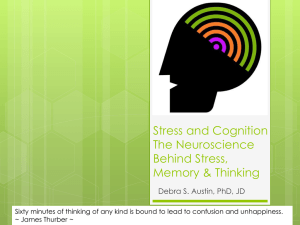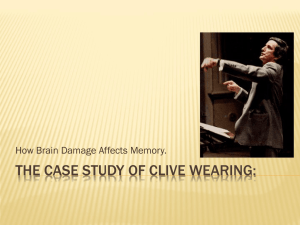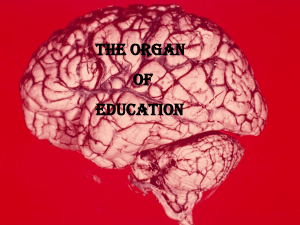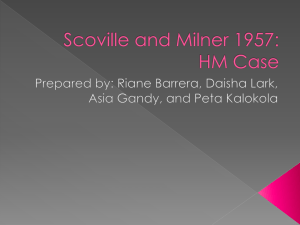Stress and Lawyering: Use Neural Self
advertisement
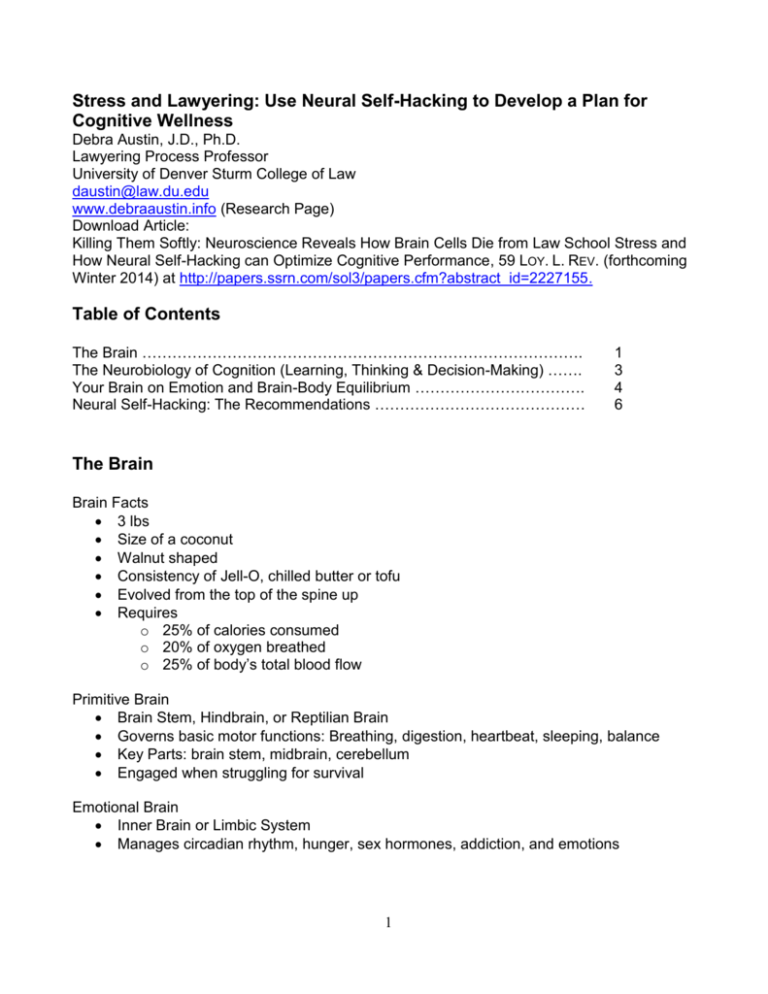
Stress and Lawyering: Use Neural Self-Hacking to Develop a Plan for Cognitive Wellness Debra Austin, J.D., Ph.D. Lawyering Process Professor University of Denver Sturm College of Law daustin@law.du.edu www.debraaustin.info (Research Page) Download Article: Killing Them Softly: Neuroscience Reveals How Brain Cells Die from Law School Stress and How Neural Self-Hacking can Optimize Cognitive Performance, 59 LOY. L. REV. (forthcoming Winter 2014) at http://papers.ssrn.com/sol3/papers.cfm?abstract_id=2227155. Table of Contents The Brain ……………………………………………………………………………. The Neurobiology of Cognition (Learning, Thinking & Decision-Making) ……. Your Brain on Emotion and Brain-Body Equilibrium ……………………………. Neural Self-Hacking: The Recommendations …………………………………… 1 3 4 6 The Brain Brain Facts 3 lbs Size of a coconut Walnut shaped Consistency of Jell-O, chilled butter or tofu Evolved from the top of the spine up Requires o 25% of calories consumed o 20% of oxygen breathed o 25% of body’s total blood flow Primitive Brain Brain Stem, Hindbrain, or Reptilian Brain Governs basic motor functions: Breathing, digestion, heartbeat, sleeping, balance Key Parts: brain stem, midbrain, cerebellum Engaged when struggling for survival Emotional Brain Inner Brain or Limbic System Manages circadian rhythm, hunger, sex hormones, addiction, and emotions 1 Key Parts (in pairs, one in each hemisphere): amygdala (panic button), hippocampus (memory processor), hypothalamus, thalamus, nucleus accumbens, and ventral tegmental Engaged when experiencing an emotional response or creating new memories Thinking Brain Cerebral Cortex o If flattened, the size of a baby blanket Key Parts o Two hemispheres linked by the corpus callosum o Four major lobes Frontal lobe (language, reasoning, movement) Occipital lobe (vision) Temporal lobe (hearing) Parietal Lobe(taste, temperature, touch) o Outer layer is gray matter - densely-packed neurons o Inner layer is white matter Engaged when using reasoning and logic to conduct higher-order thinking Brain Cells Neurons Communication nerve cells Shaped like trees Information travels from the branches (dendrites) down the trunk (axon) and across a tiny gap (synapse)to the next group of dendrites Chemicals (neurotransmitters) carry the information over the synaptic gap Electrical-Chemical-Electrical Over 100 Neurotransmitters Dopamine (motivation, pleasure, meaning); Endorphins (reduce pain, increase pleasure); Serotonin (mood, anxiety, sleep); Oxytocin (bonding); Acetylcholine (attentiveness, memory); Glutamate (learning, memory); Gamma-aminobutyric acid or GABA (slows & balances system; induces calm) Norepinephrine (mood, arousal, attention, perception, motivation). Your Connectome You are your synapses Your brain is a work in progress Neurons that fire together wire together 2 The Neurobiology of Cognition (Learning, Thinking & Decision-Making) Cognition Latin for the faculty of knowing Three Stages o Perceive Stimuli o Extract key information to hold in memory o Generate thoughts and actions to achieve goals Nondeclarative Memories Cannot be experienced in conscious awareness Procedural Memories o Stored in cerebellum (Primitive Brain) o Skiing, dancing, driving Fear Memories o Stored in amygdala (Emotional Brain) o Flashbacks and phobias Declarative Memories Require conscious thought to be recalled Stored in both Emotional and Thinking Brain Episodic Memories - Autobiographical personal experiences Semantic Memories - Learned Knowledge: facts, concepts & words Parts of the Brain Involved in Learning Thinking Brain o Frontal Lobe language, reasoning, movement o Occipital Lobe vision o Temporal Lobe hearing o Parietal Lobe taste, temperature, touch Emotional Brain o Thalamus o Amygdala o Hippocampus Laying Down a Memory Encoding: processing sensory information o Thinking Brain Information enters via the senses as memory traces o Emotional Brain Thalamus focuses attention, screens information, and sends it to the Hippocampus 3 Analytical Route Amygdala checks information for emotional content Quick and Dirty Route Consolidation: a Memory Trace is converted to Long-Term Memory and becomes stable in the brain Thinking & Emotional Brain Memory Consolidation Loop Consolidation o Information travels a neural loop from Thinking Brain (sensory lobe of origin) to Emotional Brain Hippocampus & repeats o During Sleep o Takes 2-10 years o Once memory is fully consolidated, the Hippocampus lets go of its relationship with the Thinking Brain Consolidated memories are distributed throughout the Thinking Brain in your Connectome Your Brain on Emotion and Brain-Body Equilibrium Emotion An unconscious and automatic response to an emotional stimulus that results in physical changes o increased heart rate & blood pressure o Sweaty palms o Blushing Six Primary Emotions: Fear, anger, sadness, disgust, surprise & joy Feelings Emotions are experienced as feelings Feelings are the conscious perceptions of physical emotional responses Stress 4 of the 6 primary emotions o fear, anger, sadness and/or disgust Acute Stress o Short-lived o Focus on novel intellectual challenge or resources for a significant physical challenge Chronic Stress o Long-lasting o Troubled intimate relationship, financial struggles, job loss, or treatment for a lifethreatening illness 4 Autonomic Nervous System Sympathetic Nervous System – Fight-or-Flight o SNS: arousal, defense, escape Parasympathetic Nervous System – Rest-and-Digest o PNS: nourishment, procreation, brain-body equilibrium ANS Signals Endocrine System o Secretion & regulation of hormones in bloodstream Endocrine System Main Stress Hormones: Adrenalin & Glucocorticoids Major Glucocorticoid is Cortisol Lighting Up the SNS Fight-or-Flight System Glucocorticoids tell the Autonomic System to o Elevate heart rate & blood pressure o Mobilize energy o Slow digestion o Suppress immune system Evolutionary Purpose o quick response to ensure survival SNS Fight-or-Flight Overdrive Physical o Impaired Immune Response o Increased Appetite & Food Cravings o Increased Body Fat o Increased PMS & Menopause Symptoms o Decreased Muscle Mass, Bone Density & Libido Emotional o Increased Mood Swings, Irritability & Anger o Increased Anxiety & Depression Your Brain on Glucocorticoids Suppression of Neurogenesis (birth of new brain cells) in Hippocampus Damage to Hippocampus can create cycle where greater amounts of Glucocorticoids are released, producing additional Hippocampal atrophy Hippocampal Neurodegeneration & Cell Death Impact of Stress on Cogntion Deterioration in memory, concentration, problem-solving, math performance, language processing, curiosity, creativity, and motivation Hippocampi shrink in size o Depression o Post-Traumatic Stress Disorder 5 o Repeated exposure to jet lag Chilling Out the PNS Rest-and-Digest System Conserves energy Promotes digestion and nutrient absorption Slows heart rate Lowers blood pressure Curbs the release of adrenaline and glucocorticoids Produces feelings of calm & contentment Neural Self-Hacking Neuroplasticity o allows every human brain to become what is demanded of it David Shenk - The Genius in All of Us: Why Everything You’ve Been Told about Genetics, Talent, and IQ is Wrong Boost and Heal your Brain o Reverse Hippocampal Damage o Strengthen the Hippocampus o Increase Neurogenesis Promote Memory Consolidation Activate your PNS Neural Self-Hacking: The Recommendations Exercise Enhances blood and oxygen flow o Improves blood flow deeper into body tissues o Increases blood volume in Hippocampus which maintains its health and function o Enhances distribution of food and elimination of waste o The Brain Requires 25% of calories consumed 20% of oxygen breathed 25% of body’s total blood flow Increases and balances neurotransmitters: serotonin, norepinephrine, dopamine & GABA o Dopamine (motivation, pleasure, meaning); o Serotonin (mood, anxiety, sleep); o Norepinephrine (mood, arousal, attention, perception, motivation). o GABA (slows & balances system; induces calm) 6 Stimulates production of Brain Derived Neurotropic Factor (BDNF) o Protein that helps Create new neurons Protect existing neurons Encourage synapses formation o BDNF production enhanced by Exercise Calorie Reduction Intellectual Stimulation Curcumin (active ingredient in spice Turmeric) Omega-3 Fat DHA Sleep 90 Minutes to 2 Hours to Stage 5 REM Sleep Hippocampus & Amygdala very active during REM Communication between neurons at rate equal to or higher than when awake Memory consolidation genes activated during REM, which helps formation of new neural connections Sleep Research o Subjects awakened during REM lost ability to learn new information o Loss of 1 night of sleep = 30% cognitive decline o Loss of 2 nights of sleep = 60% cognitive decline o Less than 6 hours of sleep for 5 nights in a row = 60% cognitive decline o Sleep Deprivation Diminishes attention, working memory, executive function, quantitative skills, logical reasoning ability, mood, and fine & gross motor control Accelerates Aging Process Impairs ability to use fuel/food creating risk of diabetes and obesity o Naps Naps improve cognition 26-minute nap improved NASA pilot performance by 34% 45-minute nap improved cognition for at least 6 hours Mindfulness Being fully aware of something and paying attention to the moment, with acceptance and without judgment or resistance “Just Drive” o SNS lights up when driver cuts you off o Stay calm and keep senses focused on driving o Feel steering wheel, hear engine, see road ahead, focus on destination 7 Taught at Google: Search Inside Yourself The Research: Mindfulness o Improves information processing and decision-making o Increases grey matter and connections between brain regions o Improves immune function o Decreases distraction Support for Mindfulness o Establish deliberate intention to be mindful at the beginning of any activity o At meals, reflect on where your food came from o Focus on breath while doing daily activities o Brain uses 20% of your oxygen and deep breaths increase oxygen saturation in your blood o Try to get enough sleep o Slow down o Talk less o Do one thing at a time o Simplify your life – give up lesser pleasures for greater ones Meditation Tips from Google’s Chade-Meng Tan Easy Way o Bring gentle and consistent attention to your breath for 2 minutes, and when your attention wanders, bring it back Easier Way o Sit without an agenda for 2 minutes, shift from doing to being Like weight training, growth in meditation comes from resistance When your mind wanders and you bring it back, your attention grows stronger Lesson: there is no such thing as a bad meditation The Research: Meditation o Enhances productivity, learning and health o Increases grey matter in thinking & emotional brains o Improves attention, mood, compassion o Strengthens immune system o Decreases stress-related cortisol o Improves disease & disorders o Cardiovascular, Asthma, Type II Diabetes, PMS, chronic pain, insomnia, anxiety 8 Yoga Engages both PNS and SNS o Cycling through positions Headstands light up SNS & shoulder stands cool PNS o Restores balance Increases GABA o Neurotransmitter that induces calm & improves mood and anxiety o Depression linked to low GABA o Most experienced practitioners and those who practice most have greatest increase in GABA after yoga practice The Research o Reduces metabolic rate (energy spent on bodily housekeeping) 2006 study – over 100 participants, ave. age 35 years & practiced 6 months Average of 13% reduction Men: 8% Women: 18% o Along with aerobic exercise, trains brain that signs of SNS (increased respiration & heart rate) can be a beneficial activity Thinking brain can co-opt connectome built by activity and use it for learning Relaxation Tips Activate PNS on demand o Relax your tongue and jaw o Touch your lips with your knuckle or finger o Open your lips slightly o Several long exhalations Inhale 3 beats, exhale 6 beats o For a minute or so, long & equal inhalations and exhalations Inhale 5 beats, exhale 5 beats Gratitude Practice Mindful awareness of positive events o Notice rewarding aspects of any environment to rewire connectome toward positive bias o Focus on reward increases dopamine Gratitude Journal o Things you are thankful for o People who have helped you 9 The Research o Over 100 studies, people who practice gratitude Have more positive emotions Accomplish more personal goals Sleep better & feel more alert, enthusiastic, and energetic Have lower blood pressure, and live 7-9 years longer Protect Your Brain Avoid Toxins o Alcohol works by depriving brain cells of oxygen Minimize Inflammation o Your immune system sends out cytokines when dealing with infection or allergies. Cytokines linger in the brain causing low mood and depression. o Take steps to minimize colds and flu o Avoid allergens (gluten, dairy, etc) Antidepressants o Increase the rate of neurogenesis o Includes SSRIs (selective serotonin uptake inhibitors) o Research shows exercise outperforms antidepressants Tips for Getting Started Start with aerobic exercise to increase fitness level o How much: the more fit the body, the greater the cognitive benefit o Will help your sleep Give yourself permission to make incremental progress Track your activities o Journal, Chart, or Table NIH BMI Calculator - http://www.nhlbi.nih.gov/guidelines/obesity/BMI/bmicalc.htm Add contemplative practice Suggested Reading General Brain –based Recommendations for Thriving John Medina, Brain Rules: 12 Principles for Surviving and Thriving at Work, Home, and School (2008) Contemplative Practices Rick Hanson, o Buddha’s Brain: The Practical Neuroscience of Happiness, Love and Wisdom (2009) 10 o Just One Thing: Developing a Buddha Brain One Simple Practice at a Time (2011) Chade-Meg Tan, Search Inside Yourself: Increase Productivity, Creativity & Happiness (2013) Don Miguel Ruiz: The Four Agreements (1997) Nerdy Brain Science on Exercise and Yoga John J Ratey, Spark: The Revolutionary New Science of Exercise and the Brain (2008) William J. Broad, The Science of Yoga: The Risks and the Rewards (2012) Eating Fewer Animal Proteins Rip Esselstyn o The Engine 2 Diet (2009) o My Beef With Meat (2013) 11
